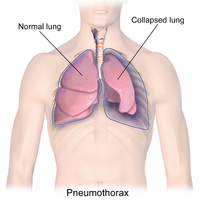
Photo from wikipedia
IntroductionPatients with primary spontaneous pneumothorax (PSP) rarely presented with radiological signs of tension pneumothorax on their presenting chest X-ray. Even though, those patients may not develop the hemodynamic instability that… Click to show full abstract
IntroductionPatients with primary spontaneous pneumothorax (PSP) rarely presented with radiological signs of tension pneumothorax on their presenting chest X-ray. Even though, those patients may not develop the hemodynamic instability that is seen in tension pneumothorax. The aim of this study is to elaborate whether the presence of radiological signs of tension pneumothorax in patients with PSP will affect their clinical presentation.MethodsRetrospective study of all cases of PSP over a period from January 2007 to December 2014. The cases were divided into two groups; tension group includes cases who have radiological signs of tension pneumothorax and non-tension group who do not have those signs. The main outcome was a comparison of the hemodynamic status of both groups.ResultsA total of 151 cases of PSP were included in the study. Radiologic signs of tension pneumothorax were identified in 13 cases of the sample. Only one case of the tension group developed hemodynamic instability in the form of desaturation to below 92% with no statistical difference between the two groups in maintaining the hemodynamic status.ConclusionIn spite that PSP can be presented with radiological signs of tension pneumothorax, those patients usually maintained their hemodynamic stability. Tension pneumothorax rarely presented as consequence of PSP.
Journal Title: Emergency Radiology
Year Published: 2018
Link to full text (if available)
Share on Social Media: Sign Up to like & get
recommendations!